battery capacity AUDI S3 SEDAN 2018 Owners Manual
[x] Cancel search | Manufacturer: AUDI, Model Year: 2018, Model line: S3 SEDAN, Model: AUDI S3 SEDAN 2018Pages: 404, PDF Size: 62.3 MB
Page 95 of 404
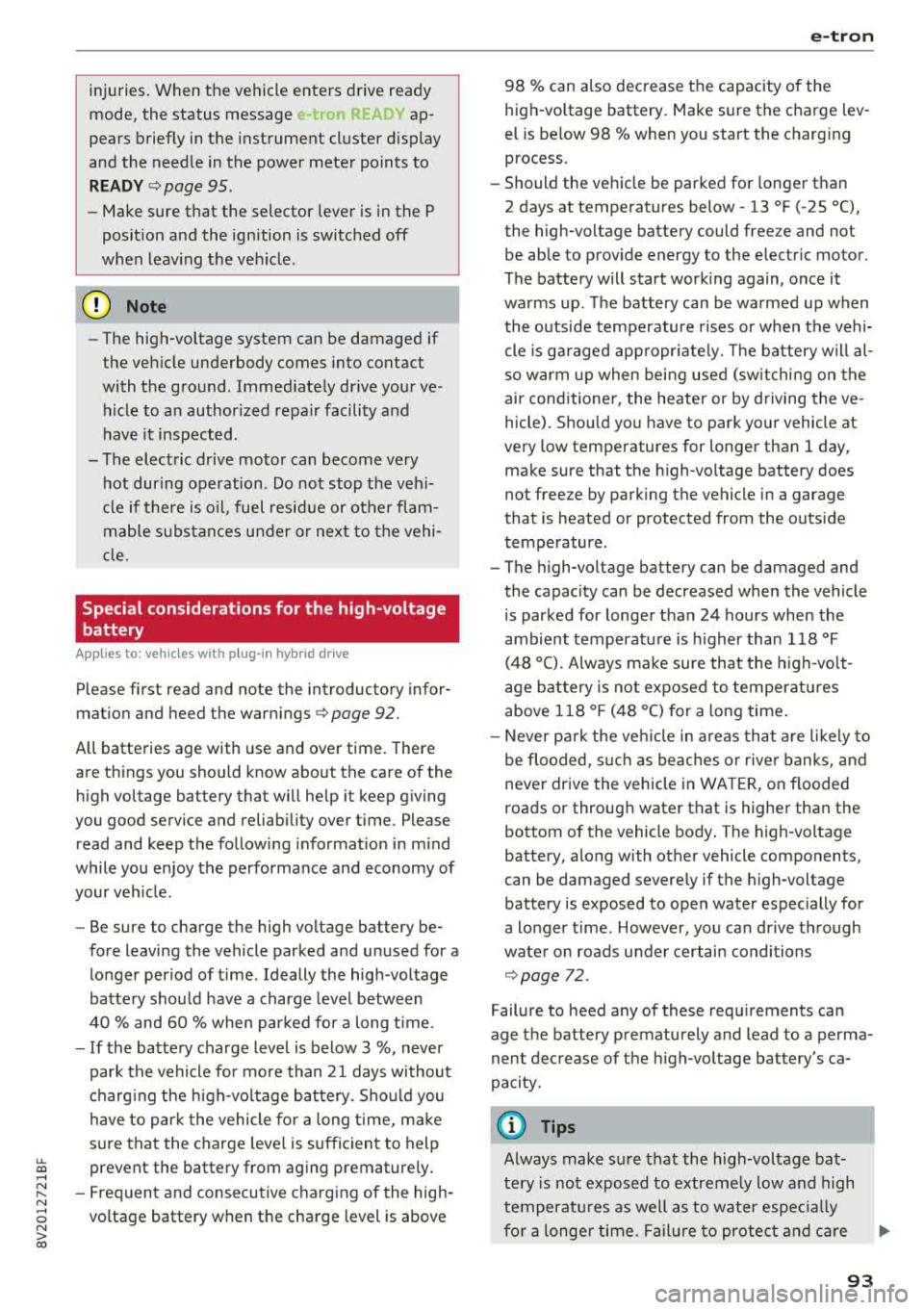
u. 00 ... N l' N ... 0 N > 00
injuries. When the vehicle enters drive ready
mode, the status message
e-no"' ~... ap
pears briefly in the instrument cluster display
and the needle in the power meter points to
READY ¢ page 9 5.
-Make sure that the selector lever is in the P
position and the ignition is switched off
when leaving the vehicle.
@ Note
-The high-voltage system can be damaged if
the vehicle underbody comes into contact
with the ground . Immediately drive your ve
hicle to an authorized repair facility and
have it inspected.
- The electric drive motor can become very
hot during operation . Do not stop the vehi
cle if there is oil, fuel residue or other flam
mable substances under or next to the vehi
cle.
Special considerations for the high-voltage
battery
Applies to: vehicles with plug-in hybrid drive
Please first read and note the introductory infor
mation and heed the warnings
¢page 92.
All batteries age with use and over time. There
are things you should know about the care of the
high voltage battery that will help it keep giving
you good service and reliability over time. Please
read and keep the following information in mind
while you enjoy the performance and economy of
your vehicle.
- Be sure to charge the high voltage battery be
fore leaving the vehicle parked and unused for a longer period of time. Ideally the high-voltage
battery should have a charge level between
40 % and 60 % when parked for a long t ime .
- If the battery charge level is below 3 %, never
park the vehicle for more than 21 days without
charging the high-voltage battery. Should you
have to park the vehicle for a long time, make
sure that the charge level is sufficient to help
prevent the battery from aging prematurely.
- Frequent and consecutive charging of the high
voltage battery when the charge level is above
e-tron
98 % can also decrease the capacity of the
high-voltage battery. Make sure the charge lev
el is be low 98 % when you start the charging
process.
- Should the vehicle be parked for longer than
2 days at temperatures below -13 °F ( -25 °C),
the high-voltage battery could free ze and not
be able to provide energy to the electric motor.
The battery will start working again, once it
warms up . The battery can be warmed up when
the outside temperature rises or when the vehi
cle is garaged appropriately. The battery will al
so warm up when being used (sw itching on the
air conditioner, the heater or by driving the ve
hicle) . Should you have to park your vehicle at
very low temperatures for longer than 1 day,
make sure that the high-voltage battery does
not freeze by parking the vehicle in a garage
that is heated or protected from the outside
temperature.
- The high-voltage battery can be damaged and
the capacity can be decreased when the vehicle
is parked for longer than 24 hours when the
ambient temperature is higher than 118 °F
(48 °C). Always make sure that the h igh-volt
age battery is not exposed to temperatures
above 118 °F (48 °C) for a long time.
- Never park the veh icle in areas that are lik ely to
be flooded, such as beaches or river banks, and
never drive the vehicle in WA TER, on flooded
roads or through water that is higher than the
bottom of the vehicle body. The high-voltage
battery, along with other vehicle components,
can be damaged severely if the high-voltage battery is exposed to open water especially for
a longer time. However, you can drive through
water on roads under certain conditions
~ page 72.
Failure to heed any of these requirements can
age the battery prematurely and lead to a perma
nent decrease of the high-vo ltage battery's ca
pacity.
(D Tips
Always make sure that the high-voltage bat
tery is not exposed to extremely low and high
temperatures as well as to water espec ially
for a longer time. Failure to protect and care
93
Page 96 of 404
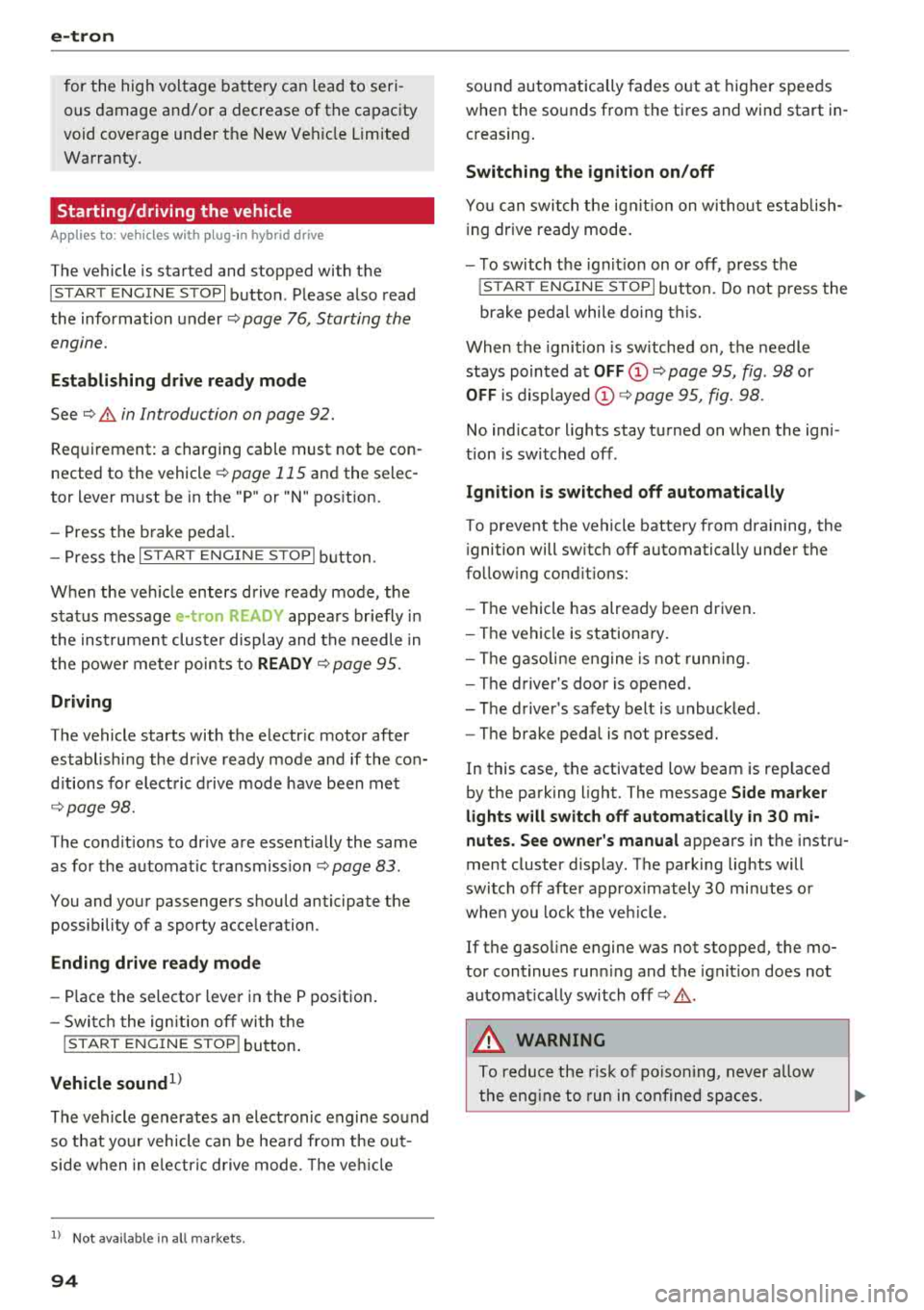
e-tron
for the high voltage battery can lead to seri
ous damage and/or a decrease of the capacity
void coverage under the New Vehicle Limited
Warranty.
Starting/driving the vehicle
A pp lies to: ve hicles w ith plug- in hybrid drive
The vehicle is started and stopped with the
IS TAR T ENGINE STOP I button . Please also read
the information under
Q page 76, Starting the
engine.
Establishing drive ready mode
See Q .& in Introduction on page 92.
Requirement: a charging cable must not be con
nected to the vehicle
Qpage 115 and the selec
tor lever must be in the "P" or
"N" position.
- Press the brake peda l.
- Press th e
I START ENGINE STOPI button .
When the veh icle enters drive ready mode, the
status message
e-tron READY appears briefly in
the instrument cluster display and the needle in
the powe r meter points to
READY Q page 95.
Driving
The vehicle starts with the electr ic motor after
establishing the dr ive ready mode and if the con
ditions for electric drive mode have been met
Qpage98.
The cond itions to drive are essentially the same
as for the automat ic transmission
Q page 83 .
You and your passengers should anticipate the
possibility of a sporty acceleration.
Ending drive ready mode
- Place the selector lever in the P position.
- Switch the ign ition off with the
I START ENGINE STOP ! button.
Vehicle sound1>
The vehicle generates an electronic engine sound
so that you r vehicle can be heard from the out
side when in electr ic drive mode. The veh icle
l) Not available in all markets.
94
sound automatically fades out at higher speeds
when the sounds from the tires and wind start in
creasing .
Switching the ignition on/off
You can switch the ignition on without establish
in g drive ready mode.
- To switch the ign ition on or off, press the
!START ENGINE STOPI button. Do not press the
brake pedal while do ing this.
When the ignition is switched on, the needle
stays pointed at
OFF CD Q page 95, fig. 98 or
OFF is displayed CD~ page 95, fig. 98.
No indicator lights stay turned on when the igni
tion is switched off.
Ignition is switched off automatically
To prevent the vehicle battery from draining, the
i gnition will switch off automatically under the
follow ing cond it ions:
- The vehicle has already been driven.
- The vehicle is stationary.
- The gasoline engine is not runn ing.
- The driver's door is opened.
- The driver's safety belt is unbuckled .
- The brake pedal is not pressed.
In this case, the activated low beam is replaced
by the parking light. The message
Side marker
lights will switch off automatically in 30 mi
nutes. See owner 's manual
appears in the instru
ment cluster display . The parking lights will
switch off after approximately 30 minutes or
when you lock the veh icle.
If the gasoline engine was not stopped, the mo
tor continues running and the ignition does not
automat ically switch off
Q & .
A WARNING
To reduce the risk of poisoning, never allow
the engine to run in confined spaces .
-
Page 113 of 404

u. 00 .-< N l' N .-< 0 N > 00
A./ appears in the box. This activation is sepa
rate from the Infotainment system settings in
the climate control menu
¢ page 116.
~ Press the I BACKI button.
~ To activate the desired timer, confirm the set
ting with the control knob.
A,/ appears in the
box .
Power save mode
Power save mode is automatically switched on
when the control unit has not been operated for
more than one minute. The
LEO @¢ page 109,
fig. 115 stays on. All other displays turn off.
~ To switch power save mode on or off, press the
~ button @¢page 109, fig. 115.
Power save mode ends automatically when the
vehicle charging connector is plugged into the ve
hicle.
The high-voltage battery is charging when the
LED@ blinks.
(D Tips
-Auxiliary climate control is powered electri
cally if you select climate control using the
charging timer. This may also be used in
confined spaces such as garages.
- Using the auxiliary air conditioning while
charging can also reduce the charge level of
the high-voltage battery.
- The high-voltage battery also charges in
power save mode.
- If the charging process is in progress, it will
not be interrupted when power save mode
switches on.
- The charging process can be interrupted at
any time. Press the active button on the ve
hicle to do this
¢page 109, fig. 116.
-The climate control output while charging
depends on the capacity of the electrical
connection. Additional information on cli
mate control can be found under
¢page 116.
e-tron
Setting the charging power level
App lies to : veh icles w it h pl ug-in hybr id drive
The control unit automatically recognizes the
voltage and the available current strength. You
can set whether you would like to charge with the
full or half of the charging power.
~ Press the I OKI@ ¢ page 109, fig. 115 button
on the control unit.
~ Enter the PIN if necessary.
~ POWER and SET PIN appear in the display
field.
~ Select POWER with the arrow button @.
~ Press the I OK I button @.
~ The charging power display appears. The cur
rent set value (50% or 100%) is marked with a
frame.
~ If necessary, change the setting using the ar
row button © to move downward or upward.
~ Press the I OK I button @.
(D Tips
- If a household socket is used for the charg
ing process, the charging power level is au
tomatically set to 100%. If multiple electri
cal consumers are connected to a circuit
'
the charging power may be limited to 50%
when charging with a household socket in
order to relieve the load on the electrical in
stallation.
- If an industrial socket is used for the charg
ing process, the charging power level is au
tomatically set to 50%. To receive the maxi
mum charging power, the value must be set
to 100% .
- A selected value remains set until the power
cable is connected again.
111
Page 116 of 404
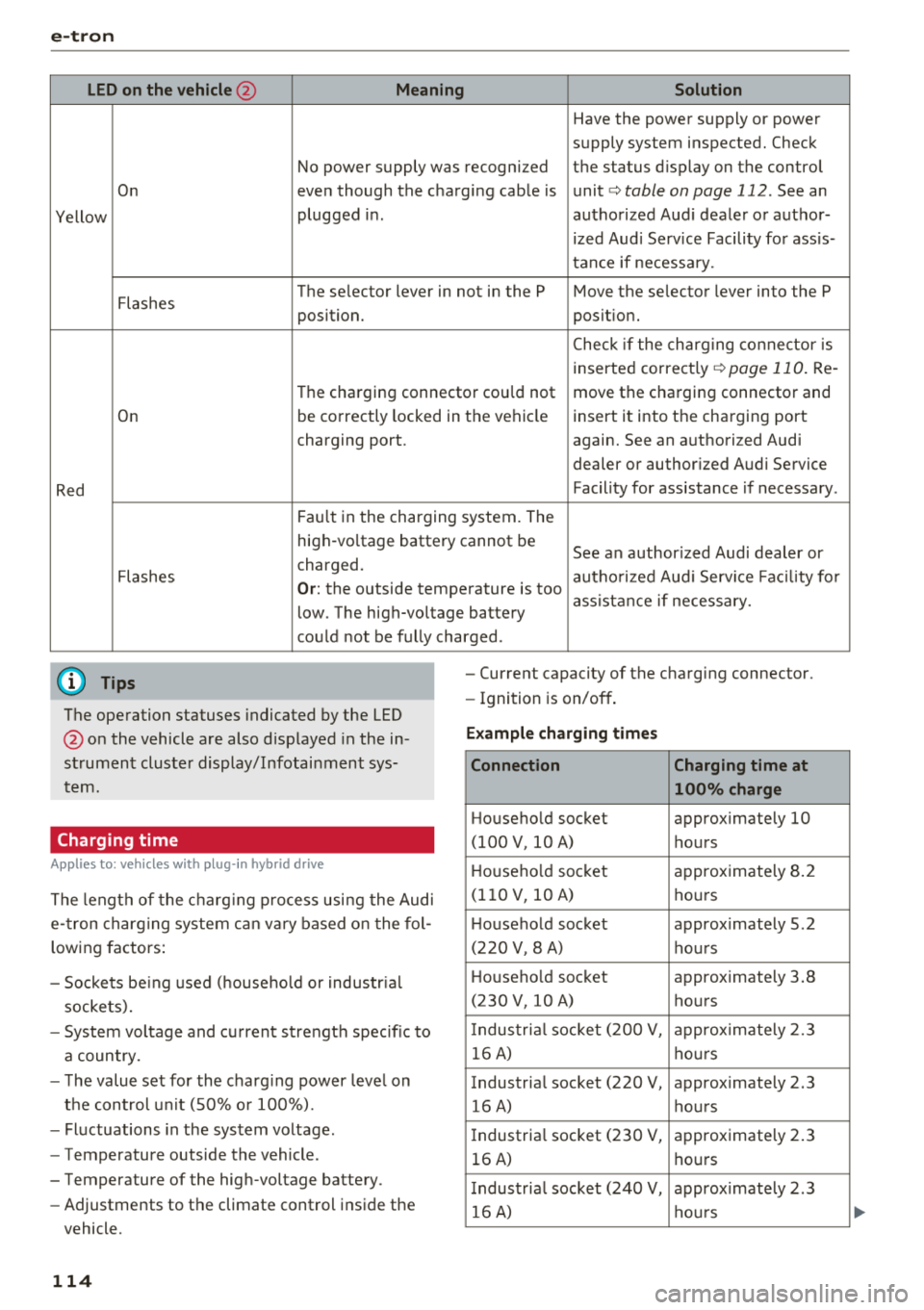
e-tron
LED on the vehicle@ Meaning Solution
Have the power supply or power
supply system inspected. Check
No power supply was recognized the status display on the control
On even though the charging cable is unit
c> table on page 112. See an
Yellow plugged
in. authorized Audi dealer or author-
ized Audi Service Facility for ass is-
tance if necessary.
Flashes The se
lector lever in not in the P Move the selector lever into the P
position. position.
C heck if the charging connector is
inserted correct ly
c> page 110. Re-
Th e charging connector cou ld not move the charging connector and
On be correctly
locked in the vehicle insert it into the charging port
charging port . again. See an authorized Audi
dealer or author ized Audi Service
Red Facility for assistance
if necessary.
Fault in the charging system. The
high -vo ltage battery cannot be
See an author ized Audi dealer or
charged.
Flashes authorized Audi Service Fac ility for
Or: the outside temperature is too
assistance if necessary.
low. The high-voltage battery
could not be fully cha rged .
(D Tips -Current capacity of the charging connector.
The operation statuses indicated by the LED
@ on the vehicle are also displayed in the in
strument cluster display/Infotainment sys
tem.
Charging time
A pp lies to: ve hicles w ith plug -in hybr id drive
The length of the charging process using the Audi
e- tron charging system can vary based on the fol
lowing factors:
- Sockets be ing used (household or industr ial
sockets).
- System voltage and current strength specific to
a country.
- The value set for the charg ing power leve l on
the control unit (50% o r 100%).
- Fluctuations in the system voltage .
- Temperature outside the vehicle.
- Temperature of the high-voltage battery .
- Adjustments to the climate control inside the
vehicle.
114
- Ignition is on/off .
Example charging times
Connection Charging time at
100% charge
Household socket approximately 10
(100 V, 10 A) hours
H ouseho ld socket approximately 8.2
(110 V, 10 A)
hours
H ousehold socket approx imately 5.2
(220 V, 8 A) hours
Household socket approximately 3
.8
(230 V, 10 A) hours
I ndustria l socket (200 V, approximately 2.3
16 A) hours
Industrial socket (220 V, approximately 2.3 16 A) hours
I ndustria l socket (230 V, approximately 2.3
16 A) hours
I ndustria l socket (240 V, approximately 2.3
16 A) hours
Page 330 of 404

Check ing and F illing
~ Applies to: vehicles with the vehicle battery in
the engine compartment: open the battery cov
er
¢ fig. 272 .
~ Applies to: vehicles with jump start point(+):
open the cover on the posi tive term inal
¢ fig . 273 .
~ Clamp the charger terminal clamps as instruct
ed on the
p os itiv e t erminal (+ ) and only on the
bo dy ground p oin t(-).
~ Inse rt the powe r cable for the charg ing device
into the socket and switch the device on.
~ At the end of the charging process, switch the
charger off and pull the power cab le out of the
socket.
~ Remove the charger terminal clamps.
~ Applies to: vehicles with the vehicle battery in
the engine compartment: fold the cover back
on the battery correctly .
~ Applies to: vehicles with jump start point(+):
close t he cover on the positive term inal.
~ Close the hood ¢ page 320.
A WARNING
-A highly exp losive mixture of gases can form
when charging batteries . On ly charge the
vehicle battery in well -venti lated areas.
- A drained vehicle battery can freeze at tem
peratures around 32
QF (0 QC). A frozen or
thawed vehicle battery must not be charged
and must not be used anymore. If ice forms,
the battery housing can crack and battery electrolyte can leak out, which increases the
risk of a n explos ion and chemical burns .
Contact an autho rized Aud i deale r or au
tho rized Aud i Serv ice Facility fo r more info r
mation .
-Do not connect o r disconne ct the c ha rg ing
cable while charg ing beca use th is increases
the risk of an exp losion.
(D Tips
-Only charge the vehicle battery through the
con nections in t he e ng ine compartment.
-Read all of the manufacture r's instructions
fo r th e cha rger befo re charg ing t he ve hicle
battery.
32 8
Windshield washer
system
Fig . 274 En gin e compar tmen t: w inds hield was he r fl ui d
cove r (example)
Observe the safety precautions ¢ page 318 ,
Working in the engine compartment .
M N
-N
"' "' m
The windshield washer fluid reservo ir W contains
the cleaning solution for the w indshield and the
headlight washer system*
¢ page 321, fig . 267 .
The reservoir capacity can be found in
¢page 382.
To reduce the risk of lime scale depos its on the
sp ray nozzles, use clean water with low amounts
of calcium . Always add w indow cleaner to the wa
ter . When the outside temperatures are cold , an
ant i-freez ing agent sho uld be added to t he wate r
so that it does no t freeze.
@ Note
-Th e concentration of ant i-freez ing agent
must be adjusted to t he ve hicle operat ing
c ondi tions i n the respective clima te . A con
centration t hat is too high can lead to vehi
cle damage .
-Never add radia to r an ti- free ze o r o ther ad di
t ives to the washer fluid.
-Do not use a glass clea ner th at conta ins
paint so lvents, because t his could damage
the paint.
Service interval display
The service interval display detects when your ve
hicle is due for service .
The service interval display works in two stages: .,.
Page 377 of 404
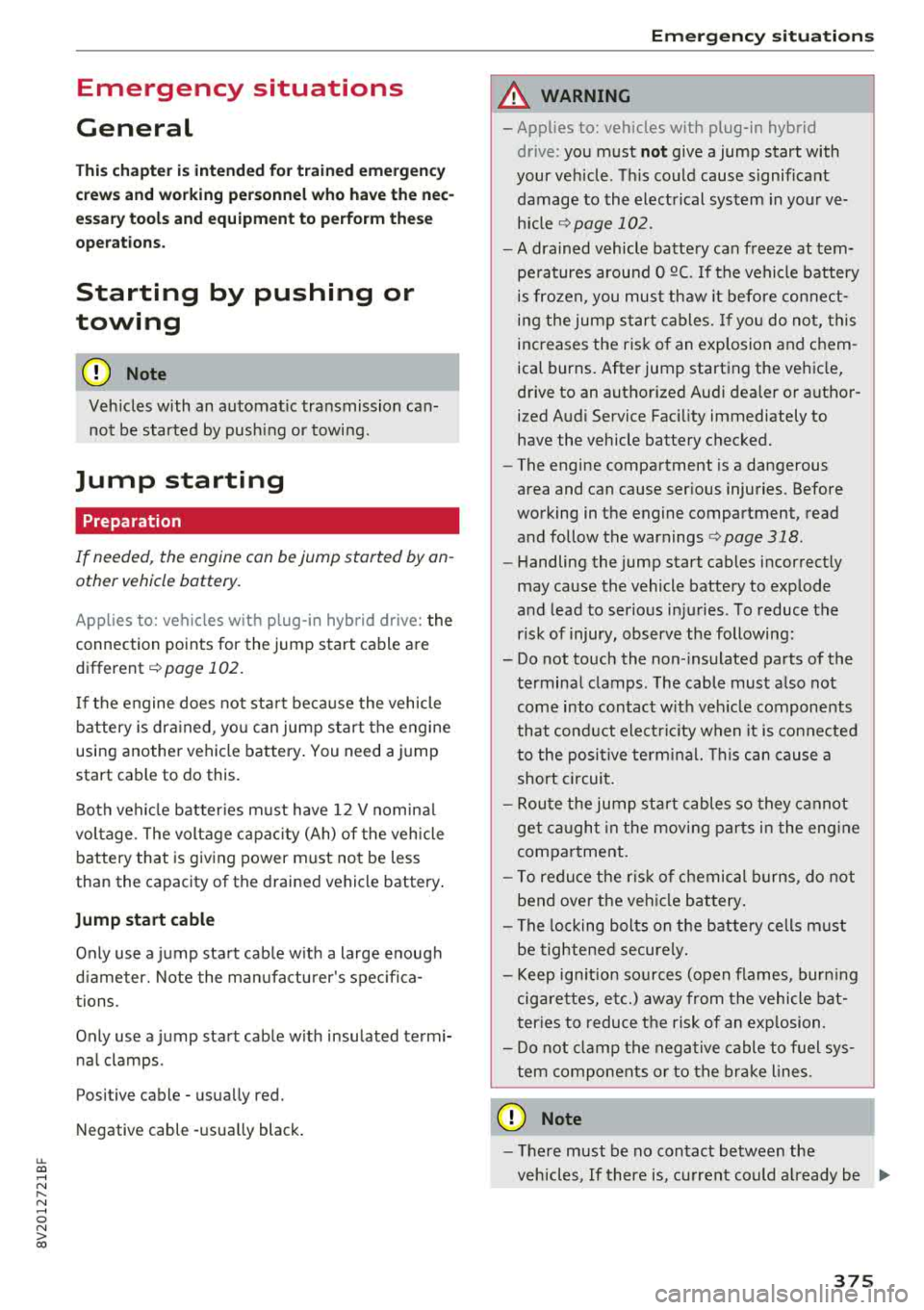
u. 00 .-< N l' N .-< 0 N > 00
Emergency situations
General
This chapter is intended for trained emergency
crews and working personnel who have the nec
essary tools and equipment to perform these
operations.
Starting by pushing or
towing
~ Note
Vehicles with an automatic transmission can
not be started by pushing or towing.
Jump starting
Preparation
If needed, the engine can be jump started by an
other vehicle battery.
Applies to: vehicles with plug-in hybrid drive: the
connection points for the jump start cable are
different
q page 102.
If the engine does not start because the vehicle
battery is drained, you can jump start the engine
using another vehicle battery. You need a jump
start cable to do this.
Both vehicle batteries must have 12 V nominal
voltage . The voltage capacity (Ah) of the vehicle
battery that is giving power must not be less
than the capacity of the drained vehicle battery.
Jump start cable
Only use a jump start cable with a large enough
diameter. Note the manufacturer's specifica
tions .
Only use a jump start cable with insulated termi
nal clamps.
Positive cable - usually red .
Negative cable -usually black.
Emergency situations
A WARNING
--
- Applies to: vehicles with plug-in hybrid
drive: you must
not give a jump start with
your vehicle . This could cause significant
damage to the electrical system in your ve
hicle
Q page 102.
-A drained vehicle battery can freeze at tem
peratures around 0
Q(. If the vehicle battery
is frozen, you must thaw it before connect
ing the jump start cables. If you do not, this
increases the risk of an explosion and chem
ical burns. After jump starting the vehicle,
drive to an authorized Audi dealer or author
ized Audi Service Facility immediately to
have the vehicle battery checked.
- The engine compartment is a dangerous
area and can cause serious injuries. Before
working in the engine compartment, read
and follow the warnings
Qpage 318.
- Handling the jump start cables incorrectly
may cause the vehicle battery to explode
and lead to serious injuries . To reduce the
risk of injury, observe the following:
- Do not touch the non-insulated parts of the
terminal clamps. The cable must also not
come into contact with vehicle components
that conduct electricity when it is connected
to the positive terminal. This can cause a
short circuit.
- Route the jump start cables so they cannot
get caught in the moving parts in the engine
compartment.
- To reduce the risk of chemical burns, do not
bend over the vehicle battery.
- The locking bolts on the battery cells must
be tightened securely.
- Keep ignition sources (open flames, burning
cigarettes, etc.) away from the vehicle bat
teries to reduce the risk of an explosion.
- Do not clamp the negative cable to fuel sys tem components or to the brake lines.
(LlJ} Note
- There must be no contact between the
vehicles, If there is, current could already be
.,.
375
Page 402 of 404
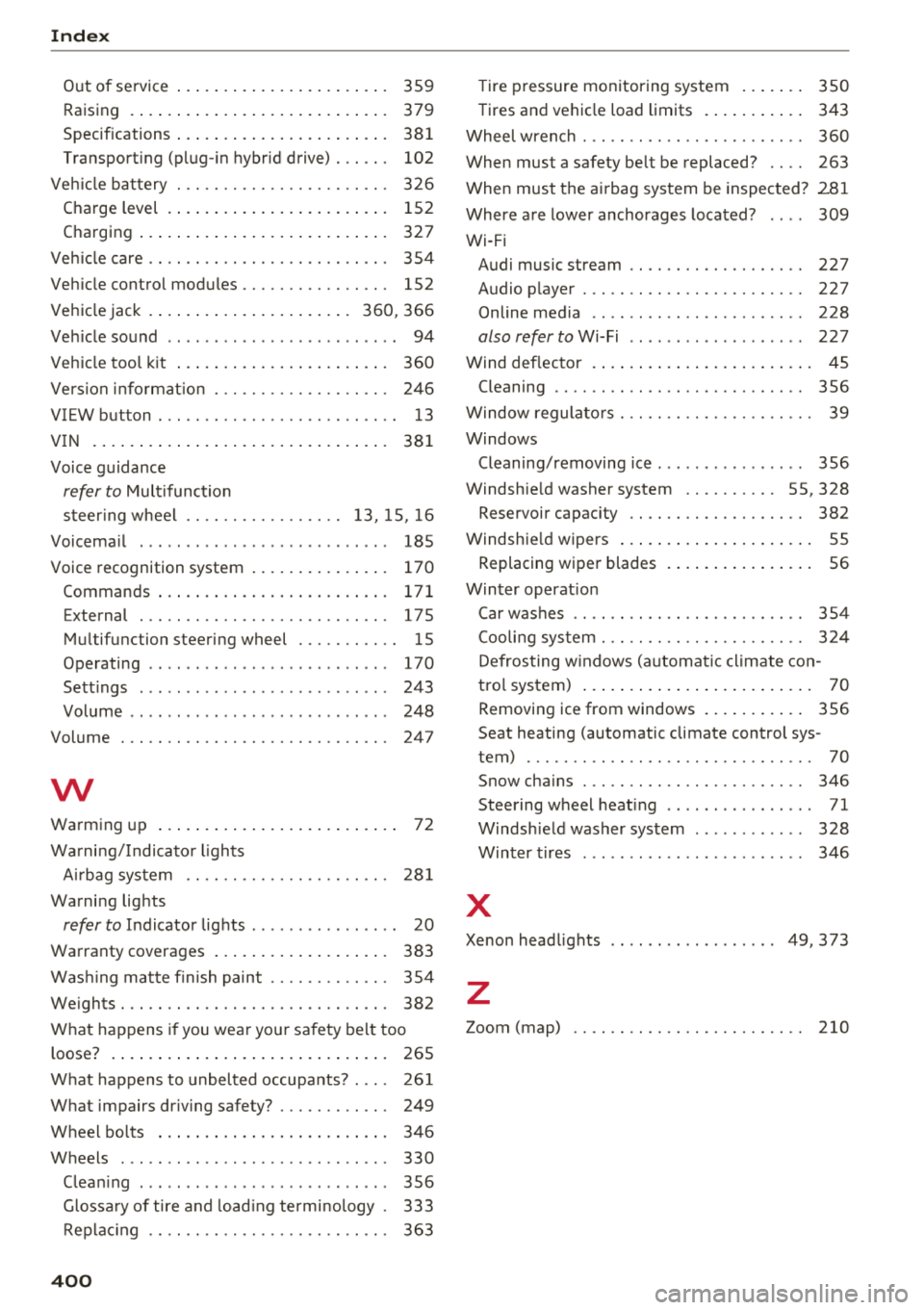
Index Out of service . . . . . . . . . . . . . . . . . . . . . . .
359
Ra1s1ng . . . . . . . . . . . . . . . . . . . . . . . . . . . . 379
Specifications . . . . . . . . . . . . . . . . . . . . . . . 381
Transporting (plug-in hybrid drive) . . . . . . 102
Veh icle battery . . . . . . . . . . . . . . . . . . . . . . . 326
Charge level . . . . . . . . . . . . . . . . . . . . . . . . 152
Charging . . . . . . . . . . . . . . . . . . . . . . . . . . . 327
Vehicle care.. .. .. ............. .. .. .. . 354
Vehicle control modules. . . . . . . . . . . . . . . . 152
Vehicle jack . . . . . . . . . . . . . . . . . . . . . . 360, 366
Vehicle sound . . . . . . . . . . . . . . . . . . . . . . . . . 94
Vehicle tool kit . . . . . . . . . . . . . . . . . . . . . . . 360
Version information . . . . . . . . . . . . . . . . . . . 246
VIEW but ton . . . . . . . . . . . . . . . . . . . . . . . . . . 13
V IN . . . . . . . . . . . . . . . . . . . . . . . . . . . . . . . . 381
Voice guidance
refer to Multifunction
steer ing wheel . . . . . . . . . . . . . . . . .
13, 15, 16
Voicemail . . . . . . . . . . . . . . . . . . . . . . . . . . . 185
Voice recognition system . . . . . . . . . . . . . . . 170
Commands . . . . . . . . . . . . . . . . . . . . . . . . . 171
External . . . . . . . . . . . . . . . . . . . . . . . . . . . 17 5
Multifunction steering wheel . . . . . . . . . . .
15
Operating . . . . . . . . . . . . . . . . . . . . . . . . . . 170
Settings . . . . . . . . . . . . . . . . . . . . . . . . . . . 243
Volume . . . . . . . . . . . . . . . . . . . . . . . . . . . . 248
Volume . . . . . . . . . . . . . . . . . . . . . . . . . . . . . 247
vv
Warming up . . . . . . . . . . . . . . . . . . . . . . . . . . 72
Warning/Indicator lights
Airbag system . . . . . . . . . . . . . . . . . . . . . .
281
Warning lights
refer to Indicator lights . . . . . . . . . . . . . . . . 20
Warranty coverages . . . . . . . . . . . . . . . . . . . 383
Wash ing matte finish paint . . . . . . . . . . . . . 354
Weights. . . . . . . . . . . . . . . . . . . . . . . . . . . . . 382
What happens if you wear your safety belt too
loose? . . . . . . . . . . . . . . . . . . . . . . . . . . . . . .
265
What happens to unbelted occupants? . . . . 261
What impairs driving safety? . . . . . . . . . . . . 249
Wheel bolts . . . . . . . . . . . . . . . . . . . . . . . . . 346
Wheels . . . . . . . . . . . . . . . . . . . . . . . . . . . . . 330
Cleaning . . . . . . . . . . . . . . . . . . . . . . . . . . . 356
Glossary of tire and load ing terminology . 333
Replacing . . . . . . . . . . . . . . . . . . . . . . . . . . 363
400
T ire pressure monitoring system . . . . . . . 350
Tires and vehicle load limits . . . . . . . . . . . 343
Wheel wrench . . . . . . . . . . . . . . . . . . . . . . . . 360
When must a safety belt be replaced? . . . . 263
When must the airbag system be inspected? 281
Where are lower anchorages located? . . . . 309
Wi-Fi
Audi music stream . . . . . . . . . . . . . . . . . . .
227
Audio player . . . . . . . . . . . . . . . . . . . . . . . . 227
Online media . . . . . . . . . . . . . . . . . . . . . . . 228
also refer to Wi-Fi . . . . . . . . . . . . . . . . . . . 227
Wind deflector . . . . . . . . . . . . . . . . . . . . . . . . 45
Cleaning . . . . . . . . . . . . . . . . . . . . . . . . . . . 356
Window regulators . . . . . . . . . . . . . . . . . . . . . 39
Windows
Cleaning/removing ice . . . . . . . . . . . . . . . .
356
Windshield washer system . . . . . . . . . . 55, 328
Reservoir capacity . . . . . . . . . . . . . . . . . . . 382
Windshield wipers . . . . . . . . . . . . . . . . . . . . . 55
Replacing wiper blades . . . . . . . . . . . . . . . . 56
Winter operation
Car washes . . . . . . . . . . . . . . . . . . . . . . . . .
354
Cooling system . . . . . . . . . . . . . . . . . . . . . . 324
Defrosting windows (automatic climate con
trol system) . . . . . . . . . . . . . . . . . . . . . . . . .
70
Removing ice from windows . . . . . . . . . . . 356
Seat heating (automatic climate control sys-
tem) . . . . . . . . . . . . . . . . . . . . . . . . . . . . . . .
70
Snow chains . . . . . . . . . . . . . . . . . . . . . . . . 346
Steering wheel heating . . . . . . . . . . . . . . . . 71
Windshield washer system . . . . . . . . . . . . 328
Winter tires . . . . . . . . . . . . . . . . . . . . . . . . 346
X
Xenon headlights . . . . . . . . . . . . . . . . . . 49, 373
z
Zoom (map) . . . . . . . . . . . . . . . . . . . . . . . . . 210